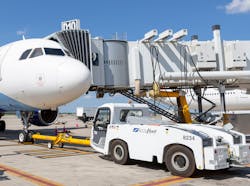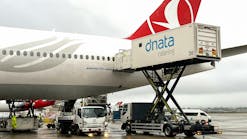Perhaps not the most glamorous part of the job, the contract between a ground service provider and an airline might be the most crucial. Without it, there wouldn’t be a job to speak of.
And like the work on the ramp, the process a ground service provider goes through in submitting a bid that is both competitive and sustainable requires a careful touch -- a process compounded when regional companies are competing with global entities.
For all, the process begins when an airline sends out a request for proposal (RFP).
“Generally, the carrier will send out an RFP to known qualified service providers when they have a new need. The need can be driven by new market entry for an airline, a significant change in service scope, ensuring that their current price is competitive or a necessary move due to an underperforming provider,” says Mike Hough, CEO of GAT Airline Ground Support.
Brian Giacona, VP of operations at AccuFleet, says that over the years, airlines have begun using one vendor for multiple services, finding there is “synergy” in the method.
“Airlines, while they're trying to get the best service, are also working on being cost conscious,” he says. “It all depends on what their needs are at the time. The carrier will provide a schedule. Sometimes they provide requirements as far as staffing and they will provide us with specifications of what exactly they're looking for. From there we will build our model based on all of their specifications.”
Sometimes, carriers will put in minimums that might exclude service providers from getting on the bid list.
“They're not going to request service from a company with a total of five employees nationwide for a contract that requires 500 people,” Giacona explains. “The large U.S. carriers, when it comes to ground handling, unless you're doing ramp service in another city for someone, they normally will not take the chance on you because they're not 100 percent sure that you know what you're doing and they don't necessarily want to take a chance with a $100 million airplane in taking someone who's green in that realm and putting them out on their ramp.”
Each respondent to an RFP determines how best to staff the operational demand, what equipment will need to be provided and what unique challenges the given airport or service will present. Then the ground handler puts its best effort at a response forward. Hough notes, however, that price is often not the sole determining factor for an airline.
“Carriers will narrow it down to those that seem to be clustered around the best price point and have the greatest capacity to do a good job. Most of our partners do not consider price as the sole determining factor. We have seen an important shift to the level of quality they will receive and we consistently market this as the ‘cost per quality unit’ equation,” Hough says.
Reputation, Mark Rudkin, AccuFleet’s director of sales and marketing, agrees is one of the critical factors.
“A lot of it comes from reputation. A lot of it comes from trust,” he says. “Making sure that the flight isn't going to be late because of something that you, as the vendor, is doing is crucial. So, having the reputation and maintaining that level of experience and trustworthiness for our airlines is a big driver.”
More Than Money
With money not being as large of a deciding factor, the field between a regional and global service provider becomes more even. Both AccuFleet and GAT say they are never in the position where they must submit a bid that is too low to stay competitive.
“We guard against it [submitting unsustainably low bids] by being committed to our values. Everyone on the GAT team knows if we cannot be sustainable, it will only damage our reputation in the long run. It is tempting to lower price to continue our growth trajectory, but we know that doing so will destroy the foundation of what we have built,” Hough says.
“We don't submit a bid to just gain work,” says Giacona. “Our first and most important thing that we do is we submit a bid that is realistic in the sense that we will not go to a customer or a potential customer and say, ‘Hey, this is the lowest price I can offer and I'm getting to it because while you require five people, I'm going to put down three.’
“We would rather go to a customer and say, ‘Look, we know we're not the lowest bidder, but this is realistically what we need to do the job,’ and we'll explain to our customer exactly how we got to that point. We want to be upfront and honest when we do a bid.”
Rudkin adds that AccuFleet drafts a detailed bid model for each proposal, populated with every assumption they are making for every market and every service line, which allows for their pricing models to be transparent and easily visible for carriers.
“They can have trust and peace of mind that it isn't just a number that we're throwing out to see whether or not it will stick, but rather it's a well thought out pricing model that comes from us actually looking at the numbers and doing the work,” Rudkin says.
AccuFleet's ability to be transparent is achieved with the help of iRod, AccuFleet’s proprietary in-house system that logs everything their employees do for a carrier.
“When the airplane arrives, we take photos of the entire airplane upon arrival showing that there's no damage to the airplane, showing that we're at the airplane providing the service. When we unload the airplane, we go onboard and show that all of the bins are empty, all of the bags have been removed, so we're not leaving anything behind or sending it back to where that airplane is going,” Giacona describes.
“We also, at the end of the flight, take pictures again of the airplane showing that we did not damage the airplane in any way, shape or form before that airplane pushes back and heads to its destination," he continues. "And all of that is uploaded into an internet-based system that our customer has a login for and they can logiin at any time and see all of those photos and see what we're doing with their airplane.”
iRod also benefits AccuFleet’s employees, streamlining worker communication and offering training, education and certification programs, which has helped AccuFleet keep turnover low. Rudkin says it is another benefit to assist AccuFleet during a bid process.
“We're driven by the idea of making ourselves a place that people prefer to work for. We want to be an employer of choice. Particularly with the ground handling world and working in airports, there's a big disadvantage in turnover if you have to wait for badging and certification to maintain the workforce that you have. So that's a big piece of it,” Rudkin says.
Hough, too, says that while larger companies may be able to offer more competitive pricing, GAT’s focus is on attention to customer satisfaction and the quality of service.
“While some of the larger ground handlers have the scale to offer more competitive pricing at times and much larger back office staff teams to aid on administrative tasks, our explosive growth is due to our commitment to quality and delivering a new kind of service provider experience. Our customers seem to be noticing the difference,” Hough details.
“Over the last three years, GAT has transformed from a solid service provider with a good reputation into a top-level provider," Hough adds. "We have differentiated by starting from a deep cultural base focused on our team and our core values and layered in best in class safety practices, technology, and data management to become consistently ranked in the top one or two service providers by our largest customers.”
Don’t Forget About the Airport
While generally not entering the process until a ground service provider and airline have agreed upon a contract, the airport where a vendor will be entering is still an important factor of the equation. Knowing an airport’s nuances can set apart one bidder from another.
“Know the airport and its key players,” Hough stresses.
Rudkin says AccuFleet incorporates the airport into their bid modeling when entering a new location.
“When we're looking at a procurement at a new airport that we haven't been in, part of the due diligence for us is to find out, what are the costs per square foot to rent office space, is it on the ramp or off the ramp? What does it cost for badging for employees?” Rudkin says. “We look at every part, whether it's a franchise fee or a service fee that the airport charges. We don't want any surprises.”
Each airport is different, says Giacona, and the service that will be provided influences what a company will need from the airport to get up and running, but every vendor will need at least an operating permit.
“Every vendor at every airport throughout the U.S. at least has to have an operating permit with that specific airport. Now depending on what type of service you're doing, the airport also may apply other restrictions to getting that permit. For example, you might have to have lease hold space, you may need to have a certain number of employees in order to operate on an airfield or at least be badged on that airfield to operate under your own permit,” Giacona says.
One if the biggest hurdles is working with airport security; getting every employee through a process of fingerprinting and background checks, which must take place before any other work can be done.
However, to begin those processes a vendor must have their contract in hand.
“The first step to any airport is obviously obtaining a contract or at least a letter of intent from a carrier that operates at that airport or is going to operate at that airport saying, ‘This is the vendor I want to use.’ That process, depending on the airport, can take three months to a year to accomplish,” Giacona says.
Giacona adds that you can do some checking beforehand on getting information, and that there is some due diligence that will be done ahead of time so when the carrier makes their decision, the vendor is ready to move forward. But even then the information is very limited.
“We recently opened up at a new airport in March. Until I physically had a letter of intent from the air carrier in hand, they wouldn't talk to me about anything,” Giacona recalls. “They would not discuss the badging process. They would not discuss rental prices on the airfield. They would not tell me if there was any office space available. As soon as I had the letter of intent from the air carrier, they gave me all of the information I wanted. They set up meetings with us on a weekly basis. So, it moves rather quickly once you have some form of letter of intent in place.”







